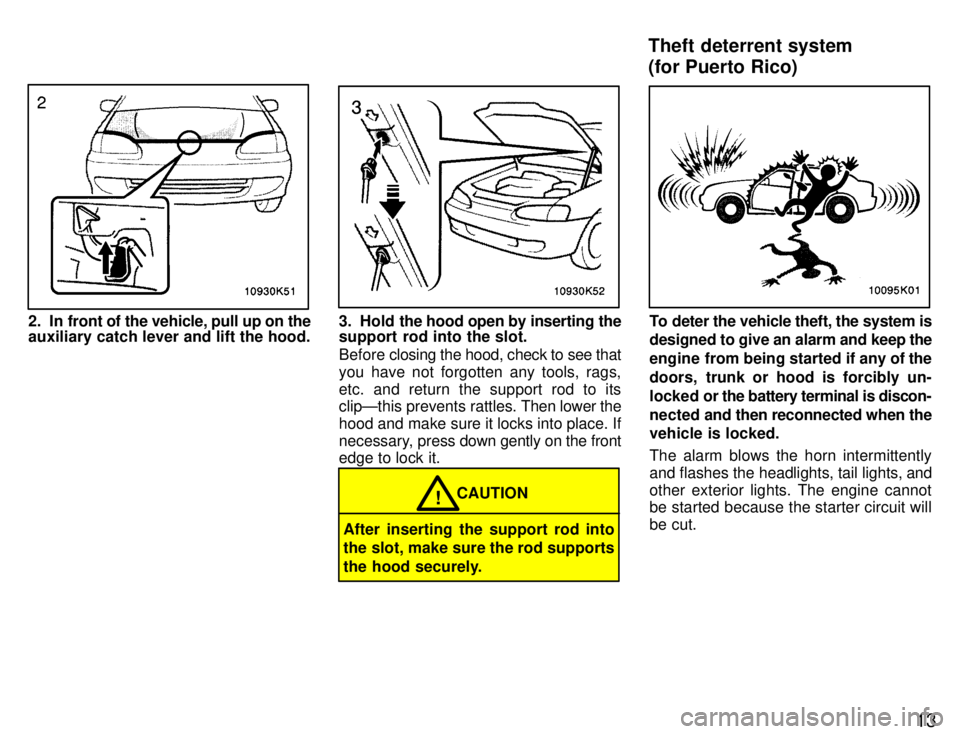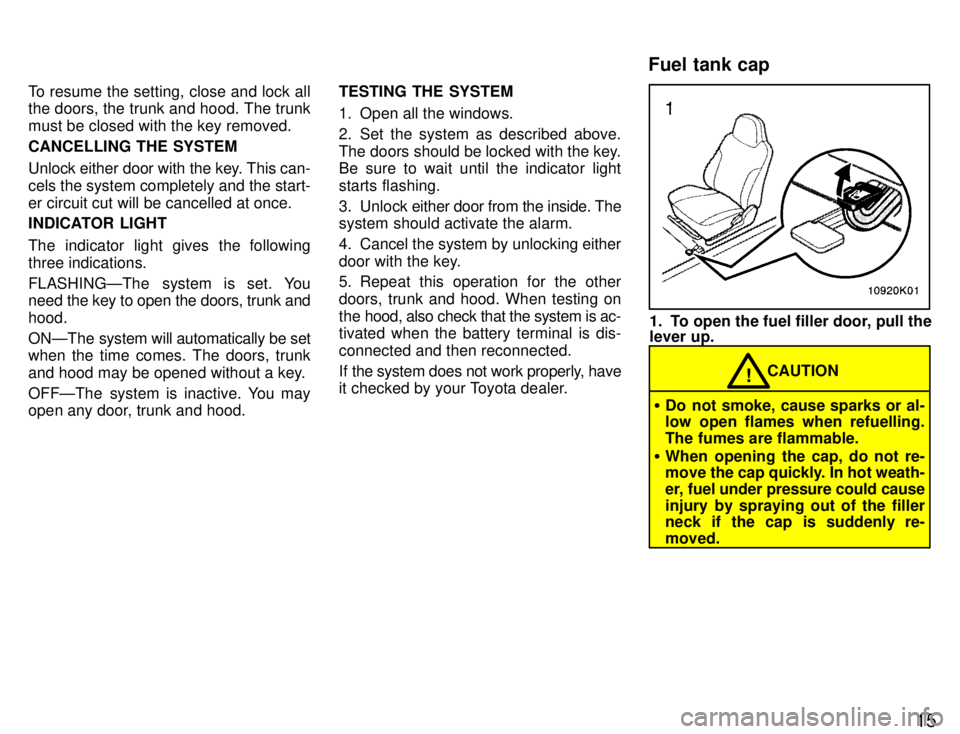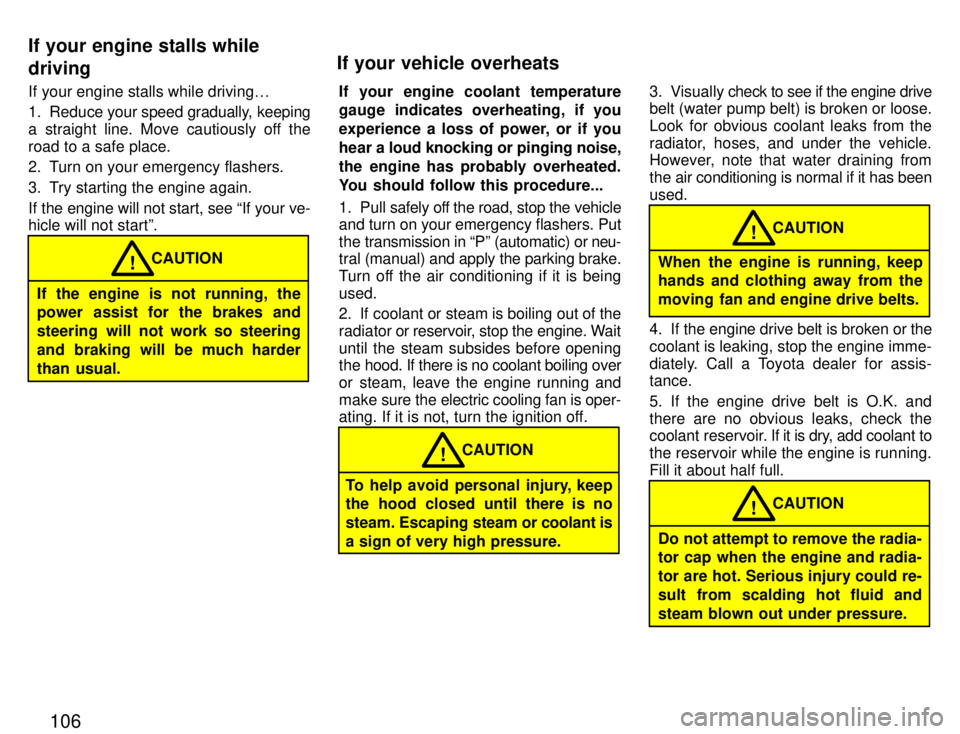1996 TOYOTA PASEO hood open
[x] Cancel search: hood openPage 13 of 165

12
This system deactivates the lock re-
lease lever so that things locked in the
trunk can be protected.
1. Push down the security lock lever
to lock the rear seatback.
After locking the rear seatback, try folding
it down to make sure they are securely
locked-otherwise, someone could getinto the trunk by folding down a rear seat.2. After closing the trunk lid, insert the
master key and turn it counterclock-
wise to deactivate the lock release le-
ver.
After closing the trunk lid, try pulling it up to make sure it is securely closed.To open the hood, do the following.
1. Pull the hood lock release lever.
The hood will spring up slightly.
ÐLuggage security system
Hood
Page 14 of 165

13
2. In front of the vehicle, pull up on the
auxiliary catch lever and lift the hood.3. Hold the hood open by inserting the
support rod into the slot.
Before closing the hood, check to see that
you have not forgotten any tools, rags,
etc. and return the support rod to its clipÐthis prevents rattles. Then lower the
hood and make sure it locks into place. If
necessary, press down ge ntly on the front
edge to lock it.
CAUTION!
After inserting the support rod into
the slot, make sure the rod supports
the hood securely.
To deter the vehicle theft, the system is
designed to give an alarm and keep the
engine from being started if any of the
doors, trunk or hood is forcibly un-
locked or the battery terminal is discon-
nected and then reconnected when the
vehicle is locked.
The alarm blows the horn intermittently
and flashes the headlights, tail lights, andother exterior lights. The engine cannot
be started because the starter circuit will be cut.
Theft deterrent system (for Puerto Rico)
Page 15 of 165

14
SETTING THE SYSTEM
1. Turn the ignition key to the ºLOCKº
position and remove it.
2. Have all passengers get out of the ve- hicle.
3. Close and lock all the doors, trunk and hood.
The indicator light come on when all the
doors, trunk and hood are closed andlocked.
As the doors are locked, the system will
give you a preparation time of 30 seconds
before the setting, during which the doors,
trunk and hood may be opened to prepare
for the setting. Be careful not to use the key when open-
ing either door. This will cancel the sys- tem.
4. After making sure the indicator light
starts fl
ashing, you may leave the vehicle.
The system will automatically be set after the preparation time passes. The indica-
tor light will flash to show the system is
set. If any of the doors, trunk or hood is
open at that time, the setting is interrupted
until it is closed and locked. Never leave anyone in the vehicle when you set the system, because unlocking
from the inside will activate the system. WHEN THE SYSTEM IS SET Activating the system
The system will give the alarm and cut the
starter circuit under the following condi- tions: � If any of the doors, trunk or hood is un-
locked without using the key
� If the battery terminal is disconnected and then reconnected
After one minute, the alarm will automati-
cally stop with the starter circuit cut kept on. Reactivating the alarm
Once
set, the system automatically resets
the alarm each time all the doors, trunk
and hood are closed after the alarm stops.
The alarm will be activated again under the following conditions. � If any of the doors, trunk or hood is opened
� If the battery terminal is disconnectedand then reconnected
Stopping the alarm
Turn the ignition key from the ºLOCKº to
ºACCº position. The alarm w ill be stopped
with the starter circuit cut kept on. Stop-
ping the alarm in this manner will keep the
alarm from being reactivated when any of
the doors, trunk or hood is opened. Interrupting the setting
With the system set, the trunk can be
opened with the key without activating or
cancelling the system. While it is open,
the doors and hood may be opened in
addition. However, when the battery ter-
minal is disconnected and then recon-
nected, the system is activated.
Page 16 of 165

15
To resume the setting, close and lock all the doors, the trunk and hood. The trunk must be closed with the key removed. CANCELLING THE SYSTEM
Unlock either door with the key. This can- cels the system completely and the start-er circuit cut will be cancelled at once.
INDICATOR LIGHT
The indicator light gives the following three indications.
FLASHINGÐThe system is set. You
need
the key to open the doors, trunk and
hood.
ONÐThe system will automatically be set
when the time comes. The doors, trunk
and hood may be opened without a key.
OFFÐThe system is inactive. You may
open any door, trunk and hood. TESTING THE SYSTEM
1. Open all the windows.
2. Set the system as described above.
The doors should be locked with the key. Be sure to wait until the indicator light
starts flashing.
3. Unlock eit
her door from the inside. The
system should activate the alarm.
4. Cancel the system by unlocking either
door with the key.
5. Repeat this operation for the other
doors, trunk and hood. When testing on
the hood, also check that the system is ac-
tivated when the battery terminal is dis-
connected and then reconnected.
If the system does not work properly, have
it checked by your Toyota dealer.
1. To open the fuel filler door, pull the
lever up.
CAUTION!
� Do not smoke, cause sparks or al-
low open flames when refuelling.
The fumes are flammable.
� When opening the cap, do not re-
move the cap quickly. In hot weath-
er, fuel under pressure could cause
injury by spraying out of the filler
neck if the cap is suddenly re- moved.
Fuel tank cap
Page 109 of 165

106
If your engine stalls while driving
0
1. Reduce your speed gradually, keeping
a straight line. Move cautiously off the
road to a safe place.
2. Turn on your emergency flashers.
3. Try starting the engine again.
If the engine will not start, see If your ve-
hicle will not startº.
If the engine is not running, the
power assist for the brakes and
steering will not work so steering
and braking will be much harder
than usual. CAUTION
! If your engine coolant temperature
gauge indicates overheating, if you
experience a loss of power, or if you
hear a
loud knocking or pinging noise,
the engine has probably overheated.
You should follow this procedure...
1. Pull safely off the road, stop the vehicle
and turn on your emergency flashers. Put
the transmission in Pº (automatic) or neu-
tral ( manual) and apply the parking brake.
Turn off the air conditioning if it is beingused.
2. If coolant or steam is boiling out of the
radiator or reservoir, stop the engine. Wait
until the steam subsides before opening
the hood. If there is no coolant boiling over
or steam, leave the engine running andmake sure the electric cooling fan is oper-
ating. If it is not, turn the ignition off.
To help avoid personal injury, keep
the hood closed until there is no
steam. Escaping steam or coolant is
a sign of very high pressure. CAUTION
! 3. Visually
check to see if the engine drive
belt (water pump belt) is broken or loose.
Look for obvious coolant leaks from the
radiator, hoses, and under the vehicle.
However, note that water draining from
the air conditioning is normal if it has beenused.
When the engine is running, keep
hands and clothing away from the
moving fan and engine drive belts. CAUTION
!
4. If the engine drive belt is broken or the
coolant is leaking, stop the engine imme-
diately. Call a Toyota dealer for assis- tance.
5. If the engine drive belt is O.K. and there are no obvious leaks, check the
coolant reservoir. If it is dry, add coolant to
the reservoir while the engine is running. Fill it about half full.
Do not attempt to remove the radia-
tor cap when the engine and radia-
tor are hot. Serious injury could re-
sult from scalding hot fluid and
steam blown out under pressure. CAUTION
!
If your engine stalls while driving
If your vehicle overheats
Page 128 of 165

125
Tire surface and wheel nuts Check the tires carefully
for cuts, damage
or excessive wear. See Chapter 7-2 for
additional information. When checking the tires, make sure no nuts are missing,
and check the nuts for looseness. T ighten
them if necessary.
Tire rotation
Rotate the tires every 12000 km (7500
miles). See Chapter 7-2 for additional in-formation.
Fluid leaks Check underneath for leaking fuel, oil, wa-
ter or other fluid after the vehicle has been
parked for a while. If you smell fuel fumes
or notice any leak, have the cause found
and corrected immediately. Doors and engine hood Check that all doors including trunk lid op-
erate smoothly and all latches lock se-
curely. M ake sure the engine hood secon-
dary latch secures the hood from opening
when the primary latch is released. INSIDE THE VEHICLE Items listed below should be checked
regularly, e.g. while performing peri-
odic services, cleaning the vehicle,etc. Lights Make sure the headlights, stop lights, tail lights, turn signal lights, and other lights are all working. Check headlight aim. Service reminder indicators and
warn-
ing buzzers Check that all service reminder indicators
and warning buzzers function properly. Steering wheel
Check that it has the specified freeplay.
Be alert for changes in steering condition,such as hard steering or strange noise. Seats Check that all front seat controls such as
seat adjusters, seatback recliner, etc. op- erate smoothly and that all latches lock
securely in any position. For folding-down
rear seatback, check that the latches lock
securely. Seat belts
Check that the seat belt system such as
buckles, retractors and anchors operate
properly and smoothly. Make sure the belt
webbing is not cut, frayed, worn or dam-aged. Accelerator pedal Check
the pedal for smooth operation and
uneven pedal effort or catching. Clutch pedal Check the pedal for smooth operation. Brake pedal Check the pedal for smooth operation and
that the pedal has the proper clearance. Check the brake booster function. Brakes
At a safe place, check that the brakes do not pull to one side when applied. Parking brake Check that the lever has the proper travel and that, on a safe incline, your vehicle is
held securely with only the parking brake applied.
Automatic transmission Parkº mech-
anism
Check the lock release button of the se-
lector lever for proper and smooth opera-
tion. On a safe incline, check that your ve-
hicle is held securely with the selectorlever in Pº position and all brakes re-leased.
Page 154 of 165

151
Light
bulbs
Bulb
No.WType
HeadlightHB260/55A
Parking, front side marker and front turn signal lights115727/8B
Rear side marker lights1685C
Rear turn signal lights115627B
Stop and tail lights115727/8B
Tail light11578B
Back-up lights115627B
License plate lightW5W5C
High mountedstop light*P21W21Bgstop light*115627B
Personal lights-8D
A: HB2 halogen bulbs B: Single end bulbs
C: Wedge base bulbsD: Double end bulbs
*: You may use either a 21w or 27w bulb.
1. Open the hood. Remove the plastic
cover.2. Unplug the connector. Remove the
rubber cover. If the connector is tight, wiggle it.
ÐHeadlights